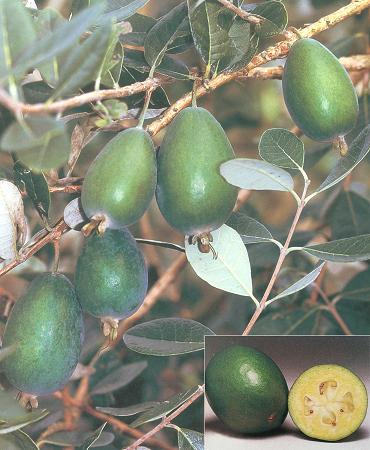Feijoa
Author:adminTime:2025-03-07

Feijoa, also called Pineapple Guava in California area of USA, is an evergreen shrub, originating in the south of Brazil, the north of Argentina, the north of Paraguay, and Uruguay.
The scientific name of feijoa is Feijoa sellowiana Berg or Acca sellowiana (Berg) Burret. It belongs to the family Myrtaceae.
German botanist Fredrich Sellow collected Feijoa plant specimen in 1815 in an area called Pelotas which located at the junction of the south of Brazil and Uruguay; In 1856, German botanist Otto Berg named it Orthostemon sellowianus, but then he found the generic name Orthostemon had already been used for a completely different genus, therefore he renamed it Feijoa sellowiana, honouring Joam da Silva Feijo, Director of the Museum of Natural History in Pelotas. In 1941, Burret showed that the structures of the flowers and fruits of Feijoa were similar to another older genus Acca, so he merged it into the genus Acca and thus the scientific name Acca sellowiana.
Artificial domestication and cultivation of feijoa began in the end of 19th century. In 1890, French botanist and horticulturist Edouard Andre introduced feijoa to Europe; then feijoa was spread to many other countries. Breeding of feijoa has been carried out in France, Israel, Italy, Russia, USA, Columbia, and especially in New Zealand. From the beginning of 20th century, much breeding work of feijoa has been carried out in New Zealand, and a series of new cultivars have been released. At present, there are substantial scales of commercial cultivation of feijoa in New Zealand, Uruguay, California of USA, south area of Russia, Sicily of Italy, and Portugal.
The fruit of Feijoa has green skin, sweet and juicy taste, and rich aroma. It has a mixed flavor of pineapple, strawberry and other fruits. It can be eaten fresh, or be processed into juice or wine; all are high-end products.
Feijoa has good medicinal functions. In its native area, local people collect feijoa leaves and fruits and prepare as an infusion for the treatment of dysentery and cholera.
Feijoa is also a good ornamental plant. It has beautiful plant shape, large and attractive flowers, and long flowering period. It is tolerant to cold winter, and drought and salty soil conditions.
Researchers of Yanoon BioTech began research on feijoa in 1993, which has been supported as a key project by the Ministry of Agriculture of China. A series of cultivars have been introduced from New Zealand. At present, Yanoon BioTech is carrying out extensive breeding of feijoa.
- Prev:Noth
- Next:Noth

